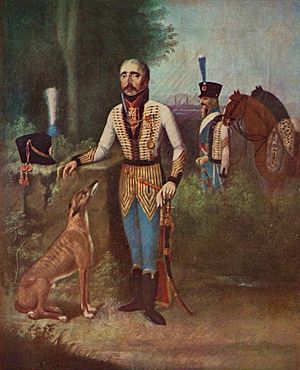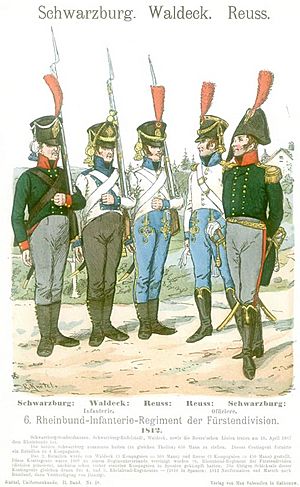François Xavier de Schwarz facts for kids
Quick facts for kids
François Xavier de Schwarz
|
|
|---|---|

François Xavier de Schwarz as Colonel of the 5th Hussar Regiment. Painting by Revel, 19th century.
|
|
| Born | 8 January 1762 Baden |
| Died | 9 October 1826 (aged 64) |
| Allegiance | |
| Service/ |
Cavalry, Infantry |
| Rank | General of Brigade |
| Battles/wars | War of the First Coalition Battle of Tory Island (1798) (POW) Battle of Messkirch (1800) Battle of Biberach (1800) Battle of Hohenlinden (1800) Battle of Austerlitz (1805) Battle of Prenzlau (1806) Capitulation of Stettin (1806) Battle of Golymin (1806) Battles of the Bruch (1808) Battle of Manresa (1810) Battle of La Bisbal (1810) (POW) |
| Awards | Légion d'Honneur, CC 1805 |
| Other work | Baron of the Empire, 1808 |
François Xavier de Schwarz (born January 8, 1762 – died October 9, 1826) was a French general. He was born in Baden, Germany, but joined the French army when he was just 14 years old in 1776.
He became a cavalry officer during the French Revolutionary Wars. He fought with the 2nd Hussar Regiment in many important battles like Jemappes, Fleurus, and Neuwied. He was captured during a failed invasion of Ireland. After this, he was promoted to lead the 5th Hussar Regiment. He led this regiment in the War of the Second Coalition, especially at the Hohenlinden.
During the time of the First French Empire, he showed great bravery at the Austerlitz in 1805. A year later, he became a brigadier general after fighting in battles like Prenzlau and Golymin. He was then sent to Spain to fight in the Peninsular War. There, he faced defeats against Spanish forces in Catalonia at Bruch Pass and Manresa. In 1810, he was captured at the La Bisbal. He spent the rest of the Napoleonic Wars as a prisoner of the British.
Contents
Early Military Career
Schwarz was born in Hernwiess, in the Margraviate of Baden, on January 8, 1762. His father was a baron of the Holy Roman Empire. Schwarz joined the French army in 1776. He served as an officer in the 2nd Hussar Regiment during the War of the First Coalition.
On September 20, 1792, three squadrons of the 2nd Hussars fought at the Battle of Valmy. On November 6, 1792, the regiment was part of the advance guard at the Battle of Jemappes. The 2nd Hussars also fought at the Battle of Hondschoote in September 1793. They were also present at the Second Battle of Wissembourg later that year.
On June 26, 1794, two squadrons of the 2nd Hussars fought at the Battle of Fleurus. The regiment helped capture the cities of Venlo and Maastricht in late 1794. They also helped seize the Dutch fleet at Texel during the winter. In 1795, the 2nd Hussars were part of Jean-Baptiste Bernadotte's division. They also fought at the Battle of Neuwied on April 18, 1797.
Promotions and Key Battles
Schwarz was part of a French attempt to help the Irish Rebellion of 1798. However, he was captured on October 12, 1798, at the Battle of Tory Island. After his capture, he was promoted to colonel (called chef de brigade) of the 5th Hussar Regiment on September 3, 1799.
In the spring of 1800, his regiment joined Antoine Richepanse's division. The 5th Hussars fought in several battles. These included the Battle of Messkirch in May, the Battle of Biberach in May, and at Kirchberg an der Iller.
Battle of Hohenlinden
On December 3, 1800, the 5th Hussars, with 596 soldiers, fought at the Battle of Hohenlinden. They were part of Richepanse's division. During the battle, Richepanse's division moved around the Austrian army's side. An Austrian force attacked the middle of their column, splitting it.
General Drouet, leading the back half, sent the 5th Hussars to push back the Austrians. While Drouet and the hussars fought the Austrians, Richepanse sent his leading regiments to attack the main Austrian army from behind. This surprise attack was a huge success and helped win the battle.
After Hohenlinden, Richepanse's division chased the retreating Austrians. The 5th Hussars fought in several smaller battles. These included Neumarkt am Wallersee on December 16, Frankenmarkt on the 17th, Schwanenstadt on the 18th, and Lambach on the 19th. In these actions, the French captured many Austrian soldiers and supplies.
Service Under Napoleon
Schwarz was honored with the Légion d'Honneur on June 15, 1804.
Battle of Austerlitz
At the Battle of Austerlitz on December 2, 1805, the 5th Hussars were part of François Étienne de Kellermann's cavalry division. This division fought on the northern side of the battle. They faced Russian and Austrian cavalry.
Emperor Napoleon ordered Marshal Jean Lannes to attack with his infantry, supported by Joachim Murat's cavalry. Kellermann's division moved forward. When Russian cavalry attacked, Kellermann's troops had to retreat behind French infantry. The infantry then fired on the Russians, making them fall back.
Kellermann's cavalry then charged, capturing some Russian cannons. But they had to pull back when more Russian cavalry appeared. Kellermann charged again, pushing back the enemy. However, French cavalry were then forced back by Russian infantry fire, and the cannons were recaptured. Kellermann was injured, and Joseph Denis Picard took command.
Picard reformed the cavalry. The 2nd Hussars and 5th Chasseurs attacked again, recapturing the cannons. The 4th and 5th Hussars broke through the Russian infantry. However, they faced strong resistance from Austrian cavalry. The fighting was very tough, but the French cavalry eventually helped defeat the enemy. For his bravery at Austerlitz, Schwarz received the Commander's Cross of the Légion d'Honneur on December 25, 1805.
War of the Fourth Coalition
In the War of the Fourth Coalition, the 5th Hussars were part of Antoine Lasalle's cavalry division. They helped defeat a Prussian force at Zehdenick on October 26, 1806. They also fought at the Battle of Prenzlau on October 28.
On October 30, 1806, the Capitulation of Stettin happened. Lasalle, with only 800 hussars, tricked the Prussian commander, Friedrich Romberg, into surrendering the fortress of Stettin and its 5,300 soldiers. Schwarz delivered the demand to surrender. He told Romberg that if Stettin was not given up by 8:00 AM, 50,000 French troops would attack, and the town would be destroyed. Romberg surrendered.
The 5th Hussars also fought at the Battle of Golymin on December 26, 1806. Schwarz was promoted to general of brigade on December 30, 1806. He became a Baron of the Empire on March 9, 1808.
Campaigns in Spain
In 1808, Schwarz was given command of a cavalry brigade in Spain. This was part of a larger French force under Guillaume Philibert Duhesme. On February 29, 1808, French troops tricked the Spanish garrison and took control of the fortress of Barcelona. This act of betrayal led to war between France and Spain.
After the Spanish people rebelled, Emperor Napoleon ordered Duhesme to send troops to capture other Spanish cities. Schwarz was given a group of 3,247 soldiers to capture Lerida. His force included Swiss, Italian, and Neapolitan soldiers, who were not considered the best troops.
Battle of Bruch Pass
On June 4, 1808, Schwarz began his mission. On June 6, he reached the Bruch Pass. There, he found 300 to 400 Spanish fighters (called miquelets) waiting in a forest. The Battle of the Bruch began when Schwarz's soldiers easily pushed the Catalans out of the woods.
More miquelets arrived, threatening Schwarz's left side. Schwarz formed his soldiers into a large square formation and began to retreat. As they retreated, the Catalans attacked them. One of Schwarz's cannons fell off a bridge and was left behind. His soldiers became disorganized and fled into the town of Martorell.
Battle of Manresa
In February 1810, Schwarz was in command of a brigade of German soldiers. He occupied the town of Manresa as a guard for the French army's side. On March 27, 1810, the French demanded that Tarragona surrender, but the Spanish commander, Henry O'Donnell, refused.
On March 30, Spanish forces attacked and captured 800 Imperial troops at Vilafranca. They then moved against Manresa, where Schwarz's troops were. On April 5, in the Battle of Manresa, the Spanish launched a full attack. They forced Schwarz's troops out of the town. Schwarz's brigade lost many soldiers, possibly two-thirds of his force. As the defeated troops fled, they were attacked again by the miquelets.
Battle of La Bisbal
Schwarz's last major setback happened at the Battle of La Bisbal on September 14, 1810. His brigade was caught in a clever plan by British and Spanish forces. The new French commander, Jacques MacDonald, moved many troops south, leaving fewer soldiers in the north. O'Donnell decided to attack the French in the north.
O'Donnell planned to move his division north to attack French forces defending the coast. Meanwhile, British ships, led by Captain Francis William Fane, sailed north. On September 10, the British captured 50 men and a coastal gun at Begur. Schwarz then told his coastal units to strengthen their defenses.
Schwarz's brigade had 1,700 men and 18 cannons. He sent 800 men to hold La Bisbal d'Empordà and the rest to defend other towns like Palamós and Sant Feliu de Guíxols. On September 13, O'Donnell, with 6,000 infantry and 400 cavalry, reached the village of Vidreres without being seen.
The next morning, O'Donnell attacked La Bisbal with a huge force. Schwarz only had time to send a message to his other units before his position was surrounded. The troops in La Bisbal retreated to an old castle. Schwarz held out until evening, but then he surrendered. He lost five killed and 19 wounded.
While La Bisbal was under attack, the other French outposts were also captured. The British seized Palamós, and Spanish forces captured Calonge and Sant Feliu. In total, Schwarz, two colonels, 56 officers, 1,183 men, and 17 cannons were captured. The Germans lost about 400 killed and wounded. Schwarz was held prisoner until the end of the war. He died on October 9, 1826.
See also
 In Spanish: François Xavier de Schwarz para niños
In Spanish: François Xavier de Schwarz para niños





